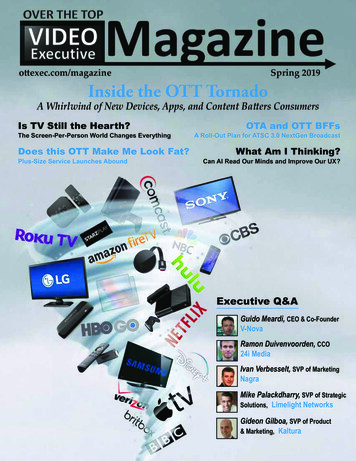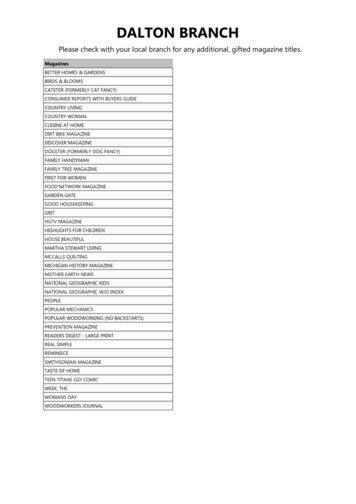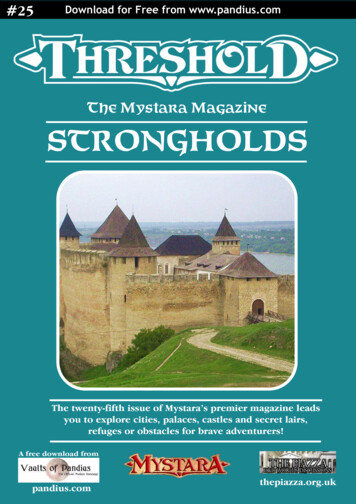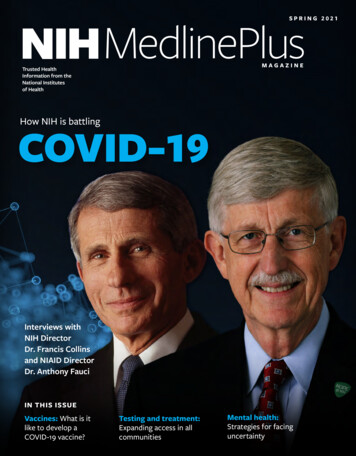
Transcription
ottexec.com/magazineSpring 2019Inside the OTT TornadoA Whirlwind of New Devices, Apps, and Content Batters ConsumersIs TV Still the Hearth?The Screen-Per-Person World Changes EverythingDoes this OTT Make Me Look Fat?Plus-Size Service Launches AboundOTA and OTT BFFsA Roll-Out Plan for ATSC 3.0 NextGen BroadcastWhat Am I Thinking?Can AI Read Our Minds and Improve Our UX?Executive Q&AGuido Meardi, CEO & Co-FounderV-NovaRamon Duivenvoorden, CCO24i MediaIvan Verbesselt, SVP of MarketingNagraMike Palackdharry, SVP of StrategicSolutions, Limelight NetworksGideon Gilboa, SVP of Product& Marketing, Kaltura
SMARTLY DIGITAL INTHE NEW OTT ERAWhether you’re a pay-TV operator or a contentowner, we can help you thrive in a convergingpay-TV and OTT world.As the lines between pay-TV and OTT continue toblur, the pay-TV industry is transitioning into a paidfor video market where the convenience of anytime,on-demand watching on any screen, reigns.Differentiation based on content exclusivity aloneis no longer enough.To grow and thrive, service providers must become‘smartly digital’. By embracing cloudification,actively claiming the aggregation role andleveraging data-driven principles to define andevolve their consumer propositions, they canembark on a journey of continuous solution renewalto optimize the next phase of growth in a vastlydifferent competitive landscape.As a trusted partner to the world’s largest mediaand communications companies and with morethan 25 years of pay-TV industry experience, wecan help you redefine your strategy toward truedigital transformation with innovative solutions thatconnect people to the content they love.CONTACT US ATDTV@NAGRA.COMCONNECTING PEOPLE TO THE CONTENT THEY LOVEDTV.NAGRA.COM
Inside this IssueCase StudiesExecutive Q&ATrends & AnalysisExecutive 2519214156The Birth of a Notion: How The Preview Channel Came to Be by William SagerOver the Top and Through AI to Big Data’s House We Go by Ted Korte2019 OTT Accolades Finalists by Brian MahonyA Labor of Love: How an OTT D2C Provider Is Lifting Millions by Katia Loisel24i Media’s Ramon Duivenvoordeni, COOV-Nova’s Guido Meardi, CEO & Co-FounderNAGRA’s Ivan Verbesselt, Senior Vice President MarketingLimelight Networks’ Mike Palackdharry, Senior Vice President, Strategic SolutionsKaltura’s Gideon Gilboa, Senior Vice President of Product and Marketing for Media & TelecomIs TV Still The Hearth? by Stephen JohnsonConsumers and Their Devices: TV in the OTT Era by Charlie NooneyBringing OTA and OTT Together: A Roll-Out Plan for ATSC 3.0 Broadcast by Fred BaumgartnerWhy the Content Hub Could be the Answer to Today’s Streaming Wars by Brice ClintonIs OTT Really More Expensive Than Other TV Buys? by David Wiesenfeld7 Predictions for Online Video in 2019 by Jim O’NeillThe Age of Plus Upon Us by Kurt MichelContent Curation Is Key by Michael NagleOTT: The Most Misunderstood Acronym in Digital Media by Jon SumberA Call for More User Control Over the Streaming UX by Virginia JulianoOTT End Game: Allow Major Players to Dominate, or Change the Rules? by David PriceHow Publishers Can Capitalize on AI This Year by David MowreyReigning in the Complexity of Monitoring OTT Streams by Erik OttoThe State of the OTT business by Mark DonniganBest PracticesWhat Is the Best Recipe for Great OTT Success? by Chris WagnerSolving the Video Marketplace Connectivity and Payments Challenge by Ed LaczynskiCloud Components as the Future of Streaming Services by Olga KornienkoDRM Pricing Demystified by Gabe EltonHandy Checklist for Ensuring User Experience When Delivering Video Streams at Large Scaleby Philippe MouawadOTT Executive Magazine Volume 8, Issue 2 - Spring 2019Published by: Trender Research Inc., 24 Village View Road, Westford, MA 01886info@TrenderResearch.comCopyright 2019 by Trender Research, Inc.The contents of this magazine may not be reproduced in whole or in part without theexpressed written consent of Trender Research, Inc.Subscriptions: www.OTTexec.com/magazine Yearly printed/mailed subscription inthe U.S.: 59.95Advertising: bmahony@OTTexec.comPrinted in the USAStaffBrian MahonyCEO, Trender ResearchFounder & Editor-in-Chief,OTT Executive MagazineNichole JanowskyPublications ManagerOTT Executive Magazine EditorKurt MichelEVP, Trender ResearchDonna BauchieroBusiness ManagerAndrea NelsonDirector of OperationsOTT ExecutiveSpring 2019 Magazine3
Executive InsightsThe Age of Plus Upon UsBy: Kurt MichelWelcome to the Spring issue of OTTExecutive Magazine, or as folks hereat Trender call it, the NAB issue. When Briangraciously offered to have me write the introto this issue, I of course accepted. But thencame the inevitable question: what to writeabout? As I thought about an appropriatetheme, it occurred to me that we are currentlysurrounded by something I call the “plus”phenomenon. Follow along and see if youagree.Recently, Apple announced AppleNews and Apple TV . For Apple, “plus”is not altogether new. It began in 1986 withMacintosh Plus, and along the way, we’veseen iTunes Plus (higher quality AACcodec without protection) and iPhones 6/7/8Plus (bigger hardware). Now it appearsthat they are embracing “ ” for their latestsubscription-based services.The rumored new Disney direct-toconsumer (D2C) service is currently beingreferred to as “Disney ”. It remains to beseen whether that will be the official brand.These premium OTT service namesfollow the lead of Hulu’s first subscriptionservice, Hulu Plus. The “Plus” distinguishedtheir subscription service from the “Hulu”free service. However, in 2015, Hulu droppedthe “Plus” branding.I’m sure the folks at CANAL are feelingpretty flattered at this point.4As I look at this, I’m seeing a pattern in theOTT subscription world. Maybe “ ” reallyshould be translated as “ ”? This might alsoexplain the demise of Google (RIP). Couldit be that naming something with a “ ” suffixand offering it without a user charge createdtoo much cognitive dissonance? (Is there apotential marketing PhD thesis here?)Then we have the video playbackdevice hardware: Roku (Express/Premiere/Streaming Stick) , Samsung Galaxy S10 ,Nokia 7 Plus, Sony Xperia 10 Plus, LGQ7 I’m sure I’m missing many others.I would have praised Amazon for its immunityfrom plus-ification– The Kindle/Fire devicesavoided it (albeit in favor of “HD,” but I’llsave the HD rant for another day, and maybeinclude “turbo” in that discussion too); butthey have finally succumbed, with Echo Plus.And it goes even further: LTE (a betterwireless), Playstation Plus (subscriptiongaming), Adblock Plus, Nike Air Max Plus,and more. Clearly, all of these brands are notjust using “plus” to mean more. They wantit to be perceived as better. (I hold onto thisbelief most fervently when I am in the plussize section of the clothing store.)I think you get my point. We are awash inPLUS!Which brings me to my real point. Ratherthan fighting the “plus” phenomenon,Trender/OTT Executive Magazine hasKurt Michel is ExecutiveVP at Trender Research.He has over 30 years’experience in telecom,datacom, and networking - in development,sales, product management and marketing roles. His marketingleadership experienceat Akamai, IneoQuest,and SeaChange giveshim a unique, multi-faceted perspective on the volatile video industry.decided to embrace it.To support that point, I present exhibit1: This issue has twice as much contentas any prior issue, and it covers a lot ofOTT topics. Our guest writers representall areas of the OTT industry, from serviceproviders to content producers, workflowvendors to network platform vendors, largemultinational brands to startups. They are allhere, bringing something for every reader.For Exhibit 2, I submit myself. Brianfelt it was time to take Trender and the OTTExecutive brand from its already highlyregarded industry position to the next level,and he began looking for someone who couldhelp him do that. Serendipitously, I was at acareer crossroads during his search, and heconvinced me that with a little bit of help,Trender/OTT Executive could evolve tooffer greater value to the OTT community.Having been a Trender customer whileleading marketing activities at Akamai,IneoQuest, and SeaChange, I alreadyknew that Brian offered great products andservices, and held himself to very highhonesty, quality and integrity standards. Ialso saw ways that I could complement whathe already offered through my engineeringdevelopment background and customer-sideexperience. So here I am at Trender, writingthis introduction.If you made it this far, I will make onecommitment to you here and now. We willnot be adding a literal “Plus” suffix to any ofour brands. But as we evolve and grow, wewant you to feel like it is there. Feel free tolet us know any time, one way or the other.Let’s Dream and Stream!
Best PracticesWhat Is the Best Recipe forGreat OTT Success?By: Chris WagnerAre you happy with your current OTTservice? With so many OTT services onthe market how can you use technology tobetter compete for viewers, subscribers, andadvertisers? Now that consumers have somany choices, and research tells us they onlywant to spend money on two to three OTTservices - will they pick yours? And to topthings off, free advertising-supported OTTservices are gaining traction in the market think Pluto TV and the Viacom acquisition.How about the latest announcement fromNBC and their future AVOD offering?There is so much content out there. So,what is the secret sauce? Can you betterleverage technology to play a more efficientrole in finding and keeping subscribers andviewers?Here is my recipe for keeping yourtechnology costs down, ensuring the deliveryof high-quality video and making sure youleverage your viewer’s “watch data” to keepthem happy.My ingredient list for great OTT success: Great Content. Let’s face it, videocontent – in all its various forms, live oron-demand, is certainly king as your firstingredient. Good content for large or smallaudiences is the fuel for your OTT service.Whether your OTT service focuses onentertainment, movies, sports or live events,content encourages viewers to engagewith your brand. This engagement offersmonetization opportunities. Delivery. Once your live and on-demandcontent strategy is underway, the delivery ofhigh-quality video to your audience is thesecond key ingredient. How important tothe consumer is the quality of your videodelivery? Just look at these numbers. U.S.digital video viewers stop watching a videowhen they encounter streaming issues. Ithas been reported that 85% of viewers stopwatching if the video stalls or rebuffers. Thesame 85% say they stop watching a video ifthe load time is too long. And finally, 57.3%stop watching if the picture quality is poor.Video delivery should include encoding andtransport processes that can support 720p,1080p and up to 4K video and Ad cues shouldbe included, plus closed captioning. Alldelivered using an adaptive bit rate practice. The Business Model. Now that yourvideo content is being delivered, yourOTT service needs to return value foryour investments. So, let’s pick the rightmoney-making strategy. Based on yourcontent strategy you should have a hybridmarketplace approach to connecting withyour audience. Leverage SVOD, AVODand transactional to get the most out ofyour content library. Your marketplaceapproach should allow for the packaging ofchannels and content in any combination andmonetizing that content in a variety of waysacross both local and international markets.Your OTT service should be flexible enoughto create and publish subscription and payper view (PPV) transactional products andpackages, localize the products for multipleregions and languages, and manage regionalpricing and promotions. Pick the most popular devices forstreaming. So now let’s pick the devicecoverage plan and strategy. When a viewerwatches content on more than one device,lifetime value and retention rates increasedrastically. When your OTT service isavailable on all the major device categoriesyour marketing efforts should be focused oncontent viewing on more than one device.OTT audiences and subscribers shouldbe measured across device categories.Customer loyalty, customer lifetime value,and higher conversion rates can be achievedby delivering relevant marketing campaignsand audience activation initiatives for multidevice engagement. Keep your viewers engaged. Helpyour viewers easily find and choose contentfrom your library. Use technology to drivesimple search, recommendation, and contentcuration. Your service should be more thana video player that just streams the content.Personalization and personally curatedlibraries are important. Become a “data freak.” The velocityof data is increasing and will alwaysincrease. Estimates suggest that global trafficwill increase three times by 2021, while thenumber of global internet users is expectedto expand from 3.3B in 2017 to 4.6B (58%of the world’s population) by 2021. VideoChris Wagner is atechnologyexpertwho partners with investors,executives,and entrepreneurs togrow their professional brands, revenues,and customers. Afterspending more thana decade in the videointernet streaming industry, Chris has developedan uncanny ability to start-up new technology businesses and enhance existing enterprises throughdigitally enabled services. He co-founded internetstart-up NeuLion and helped grow the business to 100 million dollars, which sold to Endeavor for 250million in cash.consumption, one of the largest data uses,will grow from 73% of total IP traffic to 82%,reaching 3 trillion internet video minutes permonth (that’s 5M years of video each month,or 1M video minutes per second). So, knowyour data. Knowing the “watch data” of yourviewers in now more important than ever.Your OTT service should generate and collectdata across your services. It should alsocollect customer profiles and subscriptiondata as well as transaction data and methodsof payments used for those transactions.External data should be collected about yoursubscribes from Facebook, Amazon and otherexternal data sources. Device usage metrics,data collected that represents the quality ofservice and quality of experience your OTTservice is delivering, is all important infinding and keeping viewers.So now you have the ingredients of asuccessful OTT service. Great food is createdwith great ingredients and great chefs.Consider this; the U.S. market leads the worldin adoption of OTT services with 70 percentof its broadband households subscribing toat least one OTT service. Transform yourOTT tech stack and get all of the aboveingredients working together. What’s a greatOTT outcome? The integration of digitaltechnology into all areas of your business,fundamentally changing how you operateto deliver value to your viewers. It’s also acultural change that requires OTT serviceproviders to continually challenge the statusquo, experiment, and get comfortable withfailure. Let’s make things happen! There arelots of great OTT chefs out there! OTT ExecutiveSpring 2019 Magazine5
Trends & AnalysisIs TV Still The Hearth?How a Screen-Per-Person World Changes Viewer ExperienceBy: Stephen JohnsonAt first glance a typical American livingroom in 2019 looks nothing like it did 55years ago when millions gathered around theirhearth-like televisions on a Sunday eveningto watch four mop-topped young British ladsperform on the Ed Sullivan Show. Nostalgiaaside, the powerful – nearly ingrained –experience of household members gatheringaround a glowing TV and sharing the sameexperience dictated much about how the TVbusiness itself evolved. From its earliest days,ratings, advertising models, and of coursethe long-running idea of “prime time” tracetheir roots to this simple ritual from whencewe derived the term “broadcast.” Everyonehad the same experience – so much so thatwhen emergency services or presidentswanted to reach as many people as possible,they “interrupted the broadcast” so everyonecould hear their important messages.In an OTT world this isn’t exactly howwe “watch TV” anymore – even hugelypopular, widely-shared programming. Thenumbers tell a particularly stark story: videotraffic on mobile devices (a reasonableindicator for individual viewing) continuesto rocket upward, while standard pay TVaudiences commensurately decline. Ofcourse these trends have hardly escapedthe notice of the largest content providersand distributors – increasingly the samecompanies – who, in the next year or so, planto roll out a dizzying array of mobile-friendlystreaming services. If you haven’t yet heardof products from Disney (“Disney ”), AT&T(“WarnerMedia”), Viacom, NBC Universal,Apple and others, you soon will.(Photo: LIFE)6And yet, as we’ll see, even withthese massive investments in OTT andcorresponding increases in individualizedviewing, the hearth of old hasn’t really goneaway. Good content still attracts a wideaudience, some even in the same household.But the shift is unmistakably real and willrequire examination of new business andadvertising models. Whether individualizedviewing feeds the growth of streamingservices or vice-versa, the experientialconsequences of the result are wide-reaching.Stephen Johnson is anindependent analystspecializing in videoadvertising technologyand design for mediadistributors. He established his consultancy,Coach Media, in 1998to provide services inuser experience design,information architecture, programmatic advertising, and intellectual property creation and advisement to clients worldwide.Monthly Mobile Consumer Data Traffic (in Petabytes) (Sources: Cisco/Statista)From Screen to TouchscreenAs personal tools literally made forinteraction, the phones and tablets streamingOTT content rarely sit still. Unlike the “leanback” experience with a large distant screen,a mobile device offers an irresistibly tactileset of interactive tools to either play with thecontent directly or share it with everyone youknow. Since most apps weren’t especiallydesigned with streaming in mind – indeed,to them video is merely another flavor ofunderlying media – they’ve honed viewerengagement for its own sake. Since there’san app for nearly everything, interactivityis never far from the experience – even thehighly personal one of watching a programor video.But beyond providing more fodderfor social media applications, whatdoes interactivity offer and how doesit commensurately change the viewingexperience (on any device)? No doubt theaforementioned distributors and studios havea few ideas, but their acknowledged rivalmight have a jump on them for creating anew (or rather, resuscitating an old) model:viewer-directed narrative has been recentlyshowcased by Netflix’s ‘Black Mirror:Bandersnatch,’ allowing over a trillion uniquepermutations of the same story and invitinginteractivity at every turn. While it’s possibleto imagine a roomful of viewers “playingalong,” this experience appears particularlydirected at individuals. Viewer response sofar as been positive enough that the studioisn’t overly concerned with older devices
new demographic group profiles based on amore accurate knowledge of all householdmembers. And ad-tech-friendly protocolslike MPEG-DASH support this model byallowing for alternate airings within thesame avail and programming, effectivelycustomizing the ad (and sometimes eventhe content, see above) for each individual.From at least the advertising perspective,“watching” very soon may no longer be acommon household experience at all.(Courtesy: Netflix)being unable to support the technology1.Short Attention Span TheaterProbably not unrelated to interactivity isthe average length of programming watchedon individual devices. Shows longer than 10minutes don’t even capture half the mobileaudience (compared to over 80% for thesame length on connected TVs), suggesting astrong emphasis on short form content (e.g.,“clips”). This trend hasn’t gone unnoticed byproducers2, but advertisers have largely notbothered to shift their models. Pre-rolls andbumper ads remain the distraction of choicefor nearly all SVOD services. And whilemobile hardware logistics could be drivingmuch of this preference – who wants towatch a three-hour movie on a phone? - thedifference between devices remains clear:mobile watching means shorter watching.I’m Talkin’ to YouSo unavoidable ads still introduceprograms (or even clips), but are they atleast relevant? The long-sought promise ofindividual ad targeting has almost certainlybeen oversold from a broadcast perspective,but individualized viewing has effectivelysolved the targeting part of that equationby definition. Quietly slipping through atechnology world newly obsessed withprivacy, streaming services (with the helpof new standards like ATSC 3.0) plan totarget viewers like never before. Wherebroadcast media can only aggregate anaudience or anonymize an audience of payTV subscribers, OTT viewers in a broadbandworld are relatively fair game – not leastbecause, as noted above, they’re simplyinteracting with an app and not “watchingTV” as traditionally understood. Socialnetworks, as might be expected, haveembraced viewer targeting with particulargusto.As targeting occurs within a householdand identifies individuals through theirpersonal devices, new connections andopportunities start to emerge. Customizedexperiences become possible, but so doFrom a Single Hearth to a Network ofWarm BonfiresResurgent interactivity, a preferencefor short-form content and being targetedby personalized ads look like naturaloutgrowths of individualized viewing. But,does that mean every aspect of the commonTV viewing experience is gone? Is the oldglowing TV hearth on its way to (literal)extinction?These trends appear irreversible butindividualized experience doesn’t necessarilymean solitary experience. Mobile users areclearly attached to their own devices andconsume video content on them as easily asany other activity; but evidence suggests thathardly means they refrain from sharing theexperience or otherwise being part of a crowdenjoying the same program. Ironically, thesame interactive tools that immerse mobileusers in customized content also allowthem to revel in just how many other usersare sharing the same thing. Redefining thegroup with whom we’re watching doesn’tmake watching any less intimate; indeed,a realization of collective watching deeplypersonal content may make it more so.And while it may appear a bit coldto replace gathering around the TV withinteracting over an electronic network, it’sworth remembering that the latter remainsconnected to a significantly larger, everevolving world of experiential possibilities.The vaunted “internet of things” may not berealized just yet, but other connected devicesin the home – including voice-recognizingspeakers, cameras, thermostats, evenhumble phones and TV screens – are neatlysupplementing and complementing OTTservices. If the simple experience of gatheringaround a TV expands into participation in aglobal, immersive, multi-sensory, personallytailored yet widely shared experience, it’d behard to argue we’d be the worse for it. References:1. Netflix Takes Interactive Storytelling to the NextLevel With ‘Black Mirror: Bandersnatch’, Variety,December 28, 2018 ck-mirror-bandersnatch-interactive-1203096171)2. Jeffrey Katzenberg, Meg Whitman Go Long onShort-Form Entertainment, Variety, December 11, m-entertainment-1203085867/)Online Video Consumption (Source: Ooyala)OTT ExecutiveSpring 2019 Magazine7
Trends & AnalysisConsumers and Their Devices:TV in the OTT EraBy: Charlie NooneyIt’s no surprise that consumers areinteracting with content and theirconnected devices in ways that would havebeen unimaginable even a few short yearsago, making OTT the preferred method foraccessing content. In order to predict the paththis evolution will continue to take, we mustalso begin to rethink our current assumptionsabout the consumers, their devices, and thecontent itself. In the rapidly evolving worldof TV providers, understanding that “contentis king” will be essential to delivering theservice consumers actually want. Thisupends the traditionally held notion thatviewers will come to the content if they wantit. Today’s new reality is that viewers wantthe content that they want to come to them,and providers that can do this in the mostconvenient manner will come out on top.To fully understand, we need to take a quicklook at how devices have evolved – and theresulting behavior changes in consumers.The Evolution of DevicesFor decades, the terms “television” and“TV” interchangeably referred both to thedevice used and the content itself, but thosedays are long gone. As the capabilities of TVsexpanded, so too did the number of options forcontent. During this time a similar evolutionoccurred with phones; now, the number ofcalls made with smartphones is actuallydropping, with more people indicating thattheir device’s ability to connect to the Internetis a more important feature.1 The same thingoccurred with gaming systems and accessingcontent on the Internet – more and moreoptions for accessing content are availablethan ever before, making how consumersaccess that content less relevant.While these devices have becomemuch more versatile, we have also seenthe introduction of inexpensive streamingdevices for TVs which can access contenteasily and from anywhere. These can bepurchased virtually anywhere, connectedwithin minutes and provide ubiquitousaccess to a huge variety of content services.In this world, the device itself is a secondaryconcern. Users no longer care how theyaccess the content they want; they are farmore interested in how easily it can be8accessed from the myriad of devices theymay want to use.The Current DilemmaSo, while we have come a long way interms of how much content we can offerconsumers, there is still much that can be doneto simplify and enhance the user experience.Today’s content ecosystem is, for manyindividuals, a complex web of sometimesoverlapping subscriptions, which may ormay not also include traditional cable. This isfurther complicated in homes with multipleuser profiles, especially if the viewer happensto forget one of the passwords.And while some content is shared acrossmany streaming services, other contentmay be exclusive to one service or another,meaning that the user is often forced to havemultiple subscriptions—or even differentdevices—to access all of the content theywant. Searching for a particular title may ormay not require accessing several platformsin order to find it. In sum, today’s viewersCharlie Nooney isChairman and CEOat MobiTV, Inc. He’s aseasoned media executive, with a careerdedicated to connecting media and mainstream brands withconsumersthroughemergingtechnologies. Prior to his role at MobiTV Inc., Nooney has alsoheld previous leadership positions with companiessuch as The Walt Disney Company, where he servedas executive vice president, as well as Chairmanand CEO at Premier Retail Networks; and Presidentof Broadcast Services and Out of Home Media atThomson/Technicolor.can access more content than ever before, butgiven the multitude of options, it’s not alwayseasy to access, and the experience can leavemany of them frustrated.The Modern ConsumerThese are just some of the pitfallsmany current viewers typically face, but
when we begin to think about future trendsand demographics, it becomes easier tounderstand how OTT providers can deliver abetter experience. Device users are becoming moresophisticated. They expect a personalized,user-friendly experience. Kids are gainingaccess to more devices at younger ages;with this level of native knowledge, theyintuitively know how to work them and willshow little patience for experiences that areless than ideal. Children up to age eight spendnearly 2.5 hours with a connected deviceevery day, and almost three-quarters of thattime is spent viewing TV and videos. Foreight to twelve-year-olds, this figure jumps toover 4.5 hours. In addition to this, GenerationZ and Millennials now make up over half ofthe viewing demographic in America. Theseusers know how to use technology and wanttheir experience to be personalized, easilyaccessed, and ultimately, very enjoyable. Devices are becoming less expensive.As the technological capabilities continueto make leaps and bounds while productioncosts remain low, viewing devices arebecoming more accessible to a greaterproportion of individuals than ever before.This is happening on a global scale, whichmeans that the inherent value from viewingcontent will be with the content itself, not thedevice. Mobility is important. We are all busy,which means that a substantial portion of ourday is spent outside of the home, and manyindividuals travel on a semi-regular basis forwork. Lifestyles have adapted to increasedmobility. Data is less expensive, Wi-Fi morereadily available, and 5G is around the corner.People are being conditioned to expect tohave the Internet and all of its conveniencesconstantly available. They want to take theirpersonalized experience everywhere they go,and will accept nothing less. Subscription-based access willcontinue to grow. There are over 417million household ‘media ons,exceeding the number of total Americans.These relationships come in many forms,including Internet, Pay TV, and streamingservices in video, gaming, and music.2 Thisfigure underscores the importance of thesubscription model but given consumers wantboth simplicity and choice, the experiencesaround how to bundle subscriptions is acentral question for the future. A more connected future is inevitable.With recent advances in the smart homearena, the widespread adoption of the Internetof Things (IoT), connected cars, augmentedand virtual reality, as well as artificialintelligence, a more conne
Inside the OTT Tornado Executive Q&A Guido Meardi, CEO & Co-Founder V-Nova Ramon Duivenvoorden, CCO 24i Media Ivan Verbesselt, SVP of Marketing Nagra Does this OTT Make Me Look Fat? Plus-Size Service Launches Abound Is TV Still the Hearth? The Screen-Per-Person World Changes Everything A Whir










